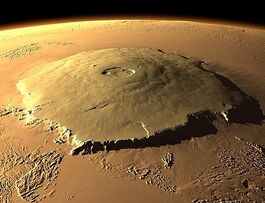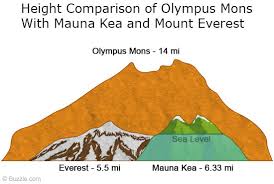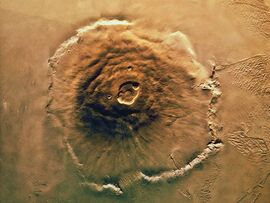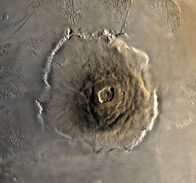
Olympus Mons (Latin for Mount Olympus) is a very large shield volcano on the planet Mars.
By one measure, it has a height of nearly 22 km (13.6 mi or 72,000 ft.) Olympus Mons stands about two and a half times as tall as Mount Everest's height above sea level. It is the tallest mountain of all planets and other rounded bodies in the Solar System, and is the second tallest mountain in the Solar System overall, after Rheasilvia on the Asteroid Vesta. It is the youngest of the large volcanoes on Mars, having formed during Mars's Hesperian Period.

It is currently the largest volcano discovered in the Solar System and had been known to astronomers since the late 19th century as the albedo feature Nix Olympica (Latin for "Olympic Snow"). Its mountainous nature was suspected well before space probes confirmed its identity as a mountain. The volcano is located in Mars's western hemisphere at approximately 18.65°N 226.2°E, just off the northwestern edge of the Tharsis bulge. The western portion of the volcano lies in the Amazonis quadrangle (MC-8) and the central and eastern portions in the adjoining Tharsis quadrangle (MC-9).

Two impact craters on Olympus Mons have been assigned provisional names by the International Astronomical Union. They are the 15.6 km (9.7 mi)-diameter Karzok crater (18°25′N 131°55′W) and the 10.4 km (6.5 mi)-diameter Pangboche crater (17°10′N 133°35′W). The craters are notable for being two of several suspected source areas for shergottites, the most abundant class of Martian meteorites.
Early Observations and Naming[]

Olympus Mons and a few other volcanoes in the Tharsis region stand high enough to reach above the frequent Martian dust-storms recorded by telescopic observers as early as the 19th century. The astronomer Patrick Moore pointed out that Schiaparelli (1835–1910) "had found that his Nodus Gordis and Olympic Snow [Nix Olympica] were almost the only features to be seen" during dust storms, and "guessed correctly that they must be high".

.
.
.
The Mariner 9 spacecraft arrived in orbit around Mars in 1971 during a global dust-storm. The first objects to become visible as the dust began to settle, the tops of the Tharsis volcanoes, demonstrated that the altitude of these features greatly exceeded that of any mountain found on Earth, as astronomers expected. Observations of the planet from Mariner 9 confirmed that Nix Olympica was not just a mountain, but a volcano. Ultimately, astronomers adopted the name Olympus Mons for the albedo feature known as Nix Olympica.
